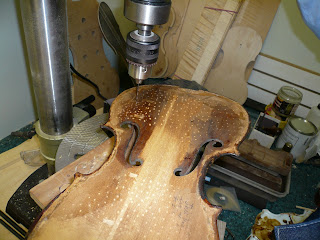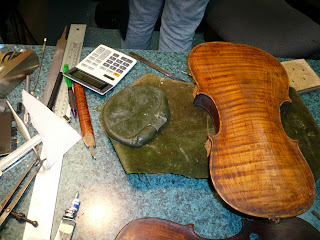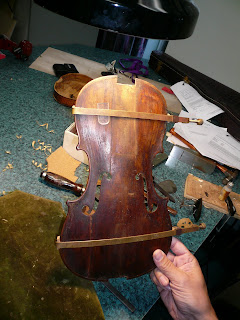Thursday, September 1, 2011
Grand Prize
The Athenaeum Pops Orchestra
The APO Dr. Samuel W. Siurua Memorial Violin No. 001
The white violin with which Ben started was a Chinese instrument made from fine aged tone wood.
 |
| Before: The Chinese white violin above arrived in March, 2011 |
 |
| After: The finished Dr. Samuel W. Siurua Violin No. 001 on August 31, 2011 |
 |
| The APO Prize SWS violin in its Bobelock case with Coda Diamond GX bow, Kuhn Shoulder Rest and Bernardel Rosin |
 |
| John Rihani shows off all the above accessories provided with generous consideration through Encore Orchestral Strings, of Paige's Music What is the Athenaeum Pops Orchestra's(APO) Young String Players Competition? It is a live performance competition for low income high school violin and viola players from the Indianapolis Public Schools (IPS) and the Indianapolis metro area. The prize awarded to one winner in each category will be a fine violin or viola. Honorariums in amounts from $50 to $200 may also be awarded 2nd and 3rd place winners. As well the two winners will perform their solos with the orchestra at an Arts Garden Concert and possible other events yet to be determined. What is the Purpose of the APO Competition? It is to further the goal of the Athenaeum Pops Orchestra to mentor younger musicians; to increase the intergenerational diversity of the orchestra string sections with young musicians; and to remember the late Dr. Samuel W. Siurua who dedicated his life to teaching hundreds of young instrumentalists during his 30 years in the Indianapolis Public Schools. What is the Athenaeum Pops Orchestra? The original Athenaeum Orchestra was organized as a zither ensemble in the 1870’s. About 1875 Emil Wulschner organized the group as an orchestra first known as The Musicverein. All the members were the finest German musicians in the city and spoke only German. From 1897 to 1918 this group was considered the finest orchestra in Indianapolis. Due to anti-German sentiment, the Musicverein was disbanded in 1918. In 1930 when the Indianapolis Symphony was organized, several members of the old Musicverein became its charter members. Constantine G. Borshoff organized the Athenaeum Turners Orchestra in 1940. Former conductors of the Turners Orchestra include David W. Hughes, Jackson Wiley, Edward Staubach and Dr. Charles Conrad. The orchestra was reorganized in 1995 as the Athenaeum Pops Orchestra, Inc. under the direction of Benjamin Winkler. It was later conducted by Richard Marcus, Peter Heins, Richard Moon and José Valencia. The Orchestra is currently under the direction of Dr. Lee H. Jones. The purpose of this organization is to contribute to the cultural aspects of the City of Indianapolis and nearby communities and groups by presenting formal and informal musical programs and concerts. The orchestra’s mission is to provide a quality playing outlet for our members that is musically rewarding, to entertain our audiences with both familiar and unusual music of high quality, and to mentor younger musicians in their goals of being better musicians. |
















































